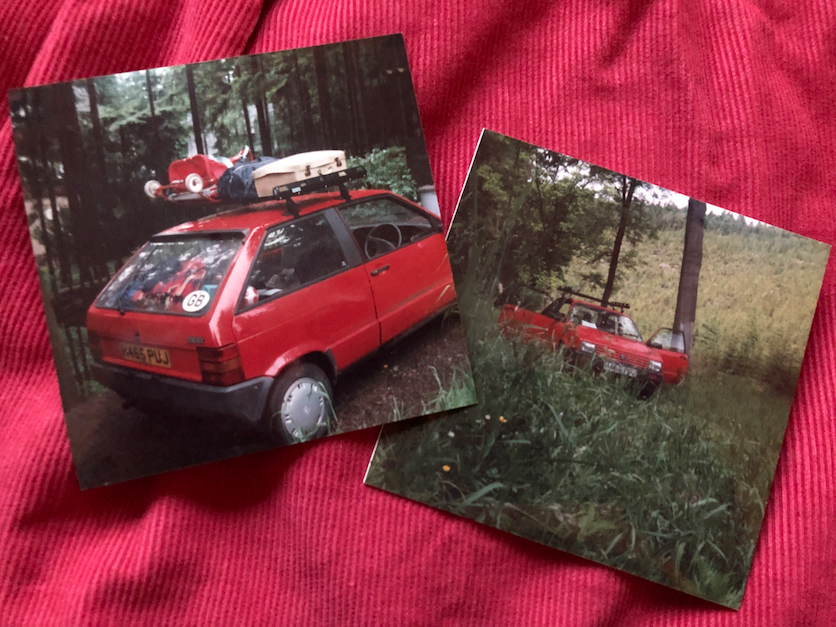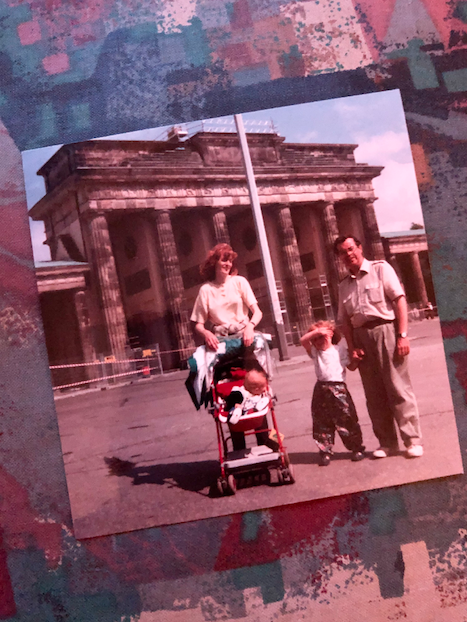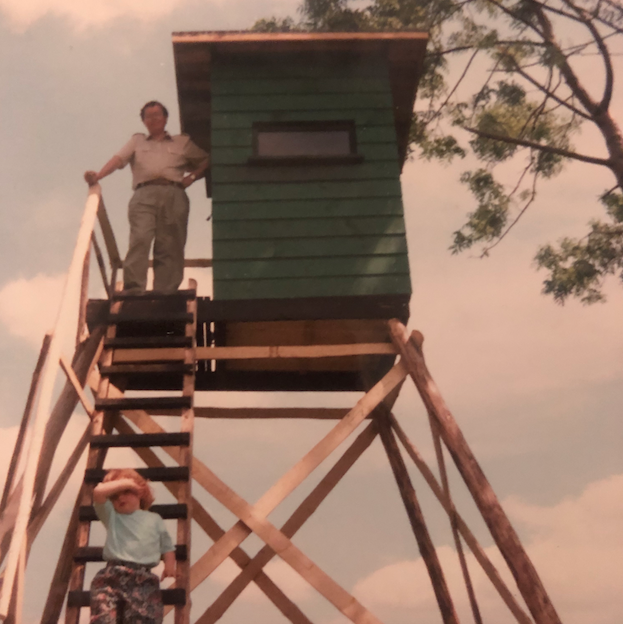It’s time for part two of my time travel series. I haven’t discovered how to travel back in time, but I did chat to my mum about a trip to East Germany we made as a family in June 1991 – during a very important time in German history.
It was eight months after the German reunification of October 1990 and 19 months after the fall of the Berlin Wall. One of the reporters who covered the seismic events in Germany was the BBC’s John Simpson:
The fall of the Berlin Wall changed the world. It brought an end to Communist regimes right across Europe, and finished Russia as a superpower.
We wanted to see the region before it changed rapidly, as it deserved to do.
None of us had ever set foot in East Germany or East Berlin. Later, as a teenager I felt a bit embarrassed that we spent so much time in Europe when other families were flying round the world. With hindsight though it was quite exciting to seek out countries that were only just opening up after the breakdown of the Soviet Union and communist control. The beach could wait.
Read on for a Q&A with my mum (aka my ‘Mutti’) about what she remembers.
Me: You’ve always loved Germany as a destination. When did you last go before 1991?

Mutti: I think it must have been 1981, when I went with my friend Marion. It was a ten day trip to Burg Eltz (south of Koblenz on the Moselle River), Vogelsburg and Rothenburg, both about as close as you could get to East Germany at the time.
Why did you want to go to East Germany?

The events on television inspired us to go for a holiday beyond the old iron curtain before it all changed. To experience it for ourselves, with your uncle Ray and you kids with us. Roof rack on, and off we went!
It seemed like the time to visit. I felt a bit like a pioneer somehow. We were going into a part of Europe that had been so closed off. Everyone had read a lot about what life was like there, and here was our chance to actually be there. We would have gone in 1990 if we could have, but your brother Stephen was soon to be born and so we waited.
Where did we stay and how did we get there?

Our destination was a village called Waldidylle, south of Dresden. It’s very close to the border with what was then Czechoslovakia (now Czechia).
We took a Stena Sealink ferry from the port of Harwich in Essex, over to Hook van Holland – literally the ‘hook of Holland’ – that juts out west of The Hague and Rotterdam.
We drove through the Netherlands and into Germany, stopping overnight somewhere en route – I can’t remember where. With small children in tow, we didn’t want to do a whole day’s drive to Waldidylle in one go.
So we travelled over two days, but we missed the owners?
Yes, we got to Waldidylle quite late. We hadn’t realised how remote it was. You navigate by car all the way from the UK to your destination, but it’s usually the last bit of the journey where you get stuck. We stopped at a pub to ask for directions and a kind stranger showed us into the village, we followed his car.
We got to the chalet and there was a note on the door from the owners saying that they had gone back to their house in Dresden because it had been getting quite late.
Did they not leave a key for us to get in?!
No! I suppose if it was their holiday home, they didn’t necessarily know the neighbours that well.
You’d think that in a sleepy rural village they’d trust the neighbours to have the keys. Maybe I’m reading into it too much, but maybe it took a while to trust neighbours again. The infamous Stasi secret police were known for extreme surveillance techniques and for turning neighbours into spies against each other. Keeping themselves to themselves was probably quite ingrained.
Anyway, we didn’t have to sleep in the car at least?
It was quite dark, so it must have been rather late seeing as we were there in June. And there were so many trees making everything darker still. We looked around for the nearest neighbours. There was a gap between our chalet and a house nearby. Like most of the properties around, it had a sloping roof for the snow in winter, and it was bigger than the chalet.
We headed over and knocked on the door to ask the family living there if they knew of a bed and breakfast. They instead offered us their house for the night.
They were maybe in their late 40s or early 50s and they had a daughter in her teens who was at a disco that evening. Perhaps they had an older daughter who had moved out already. And maybe a grandfather too, but I can’t remember much more about them.
In order to squeeze us all in, they arranged for their daughter to stay with a friend. It’s funny the things you remember – I remember that detail, but I can’t picture the couple’s faces. We were so tired and I had you two to look after.
A quick sorting of the rooms and we had beds for the night! We all slept very soundly.
Did you speak to them much?

Most of the conversation was in German, it certainly helped that I can speak a bit.
I remember chatting to our hosts in German over the breakfast table in the morning. They told us that we were the first British people they had met since the Berlin Wall had fallen. That left a real impression. They mentioned the war. I remember Dresden came up in conversation, as did Coventry (both cities were badly bombed in the Second World War).
The hosts were just so nice. We offered them money for the stay, though they wouldn’t accept more than a few pounds.
They and everyone else were so helpful to us and that has really stayed with me.
After breakfast we had to get the keys presumably?
We drove 40km over to Dresden to pick them up and spent the day discovering the city. The note on the chalet door had the address of the owners we’d missed, with instructions for how to find them. No mobile phones back then!
And we spent the rest of the trip in that chalet. I can’t really remember what it looked like (update: now I know, because we found a photo!)



It was a classic chalet in the woods, I knew I must have taken a photo! Nice to also see our trusty old SEAT car complete with buggy and travel cot on the roof. Do you remember the stuffed animal heads on the walls inside the chalet?
Yes, now you mention it! I have a vivid impression of a lot of wooden furniture and some large taxidermy on the walls.
They scared you a bit I think. We covered them with sheets and blankets.
Hopefully we remembered to remove the sheets…
Thinking back to the trip overall, and others in the 1990s, what struck you about East Germany compared to West Germany?

Despite our preconceptions, Waldidylle itself and other rural parts of East Germany didn’t strike us as much different from West Germany.
The motorway was in quite a bad state however, even around the bigger centres of Chemnitz and Leipzig. Infrastructure was noticeably in a poorer state than the West half of the country. On later trips we could tell the disconnect between East and West German roads, especially in the Harz Mountains. You couldn’t just go east to west or vice versa, you had to take detours to get from one set of roads to another.
What the regions were known for producing was different too. East Germany and East Germans had long had to rely on more traditional crafts to earn a living, making more wooden toys for example, in contrast to the grander industry of West Germany.
We visited Seiffen, only 15km from the Czech border and across from Waldidylle. They turned to wooden toy manufacturing hundreds of years earlier when the iron mining industry collapsed. We went on a day trip and of course bought you some wooden toys.
I remember that day – it was Stephen’s first birthday. He had a jelly birthday ‘cake’ and chose a wooden toy truck, while I opted for a snazzy wooden tea set. We still have them in the house.
When the waitress realised we were celebrating a birthday, she brought out a sparkler, that was nice of her.
And here’s the famous truck. Stephen keeps it pride of place among a very select number of souvenirs he’s collected over the years. By contrast you need a warehouse for all mine.


Before reunification, East Germany was known as the DDR (Deutsche Demokratische Republik) or GDR in English. You can actually see on the bottom of the wooden truck that it was first stamped with GDR, before later being stamped over with MADE IN GERMANY. Interesting!
Another difference was that things did cost a lot less in the east of course; we felt the money on our holiday lasting longer. That remained the way for many years.
I remember vividly our trip in 1998 to the Harz Mountains and the Czech Republic (the peaceful dissolution from Slovakia happened in 1993). As children we couldn’t believe our ears and eyes that ice lollies were about the equivalent of 7p or, if we wanted a fancy lolly, 13p. Heaven.
We did feel a bit of a novelty sometimes on our travels in the 1990s, a British family with young children expressly choosing to enter these formerly occupied countries when it wasn’t particularly fashionable.


We darted around quite a bit on our trip didn’t we – we went to nearby Meissen (famous for its porcelain) as well as Berlin and Colditz. We also crossed the East German border with then Czechoslovakia, venturing to Prague. And we spent some time in Dresden (pictured). It was infamously bombed in the very late stages of the Second World War, gutting most buildings. The photos show some of the famous buildings rebuilt after the war.

Yes, the city left an impression on all of us.
Even Stephen, who was 11 months old at the time, thinks he remembers seeing some remaining bomb damage.
It’s possible.

One of my strongest memories is us walking round Colditz (between Leipzig and Dresden). It was used during the Second World War to house Allied Prisoners of War (POWs), many of whom were involved in increasingly daring escape attempts as the war wore on.
I could swear I was older than 3-4 years old, I remember it as if I was about 10. I remember peering through windows as looked around, imagining some of the POWs still being inside, in their uniforms and sporting big moustaches.
Dresden, Seiffen and Colditz aside, what else do you remember from the trip?


I remember when we visited Berlin that the Brandenburg Gate was still undergoing refurbishment. The East German authorities removed the quadriga that sits on top as part of the renovations, after the wall had fallen. When we were there, it hadn’t yet gone back on.

The beautiful clothes of the children dancing in Hradčany, the castle district surrounding Prague Castle.

And the equally beautiful Old Town Square in Prague. Czechoslovakia when we visited had itself only just returned to democracy during the Velvet Revolution of 1989. Less than 1 1/2 years after our trip the country was officially dissolved and became the Czech Republic (now Czechia) and Slovakia.
Of course, we couldn’t resist visiting both new countries soon after!
Prague is an example of a city I know I’ve seen lots of, but at a very young age. Must go back one day…

And here I am with dad, surveying a scene of calm over East Germany.
What a time to travel!

What a wonderful story! I liked the interview style a lot too, and some atmospheric photos. Such memories! And as you say, travel was once so very different and quite charming (seen in retrospect!).
LikeLiked by 1 person